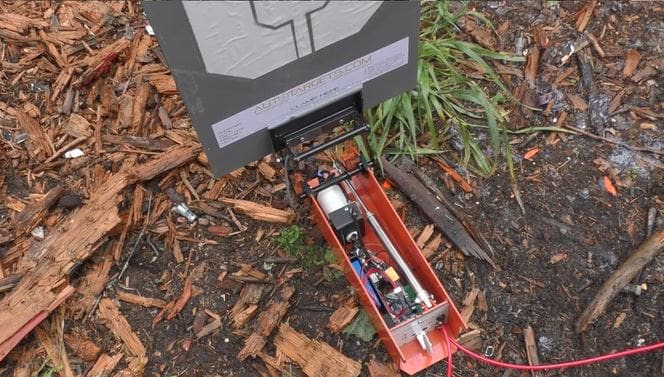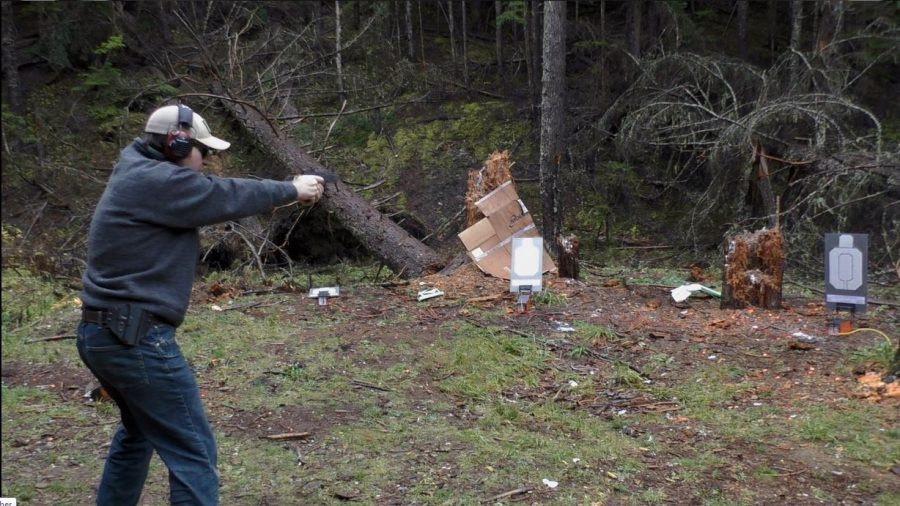https://www.youtube.com/watch?v=0VBNBwkLCjI
My time with the borrowed AutoTargets System has come to an end, but not before putting some rounds on a Gen II lifter unit with double acting pneumatics. The only gripe I had with the original setup (review here), cost aside, was that targets fell too slowly for my taste. By adding a pressure tank, Gen II units actually power their way down, cutting drop time from 800 milliseconds to as short as 150 milliseconds.
At top left inside the unit above is a small CO2 tank that’s pre-charged when the system is pressurized. It actually forces the target down when the electronics say “drop” instead of it just bleeding off gas and letting gravity take over. The strength of its downward drive is easily adjustable with the turn of a valve. Basically, fast is good but not if your targets are being smashed to bits on rough ground, so adjust accordingly.
I ran the usual whack-a-mole drills, practicing target transitions and magazine changes while targets presented themselves to me in random order. This is a hell of a good time. The faster drop of the upgraded target was definitely noticeable, and if all of my targets had the upgrade it would have made for an even more challenging, even faster-paced scenario.
In the event that the audible steel target-like “clang” the mobile app makes when bullet hits target can’t be heard by the shooter, a target that reacts significantly faster is a big deal. Most of the “did I hit it?” delay goes the way of the dodo and the shooter can move onto the next target faster and with more confidence.
A cool feature of the AutoTargets system is its integrated shot timer and scoring system. In the past I had only used this functionality for drawn out scenarios, challenging myself and some friends to various types of competition involving multiple target presentations with varying levels of difficulty (e.g. hostage taker head shot needed, failure drill needed, any hit outside the A-zone deducts points, etc.), but more recently I used it for draw drills.
Thanks to the random start delay and random target presentation options, the system can be set to surprise you with a target. It’ll then show you how long it took you to score a hit and where on the target that hit landed. Although I stayed right on “the X” for the purposes of being in-frame on the video, this sort of draw scenario is normally a useful training tool to practice drawing, moving, evading, and getting hits on target rapidly.
Of course, for timing a draw and identifying hits (and a lot of other scenarios), a lifter unit isn’t actually needed. To fill that simpler use niche at a much lower price, AutoTargets recently released its Mini-Module Static Target. Considering the significantly simpler setup, smaller size, and lower cost, I’m keen to get my hands on a couple of these for long-term use and perhaps to settle some friendly bets among the TTAG crew.
Overall, what I felt was the number one shortcoming of the original system has been very nicely resolved with the Gen II double acting pneumatic upgrade. Not only that, but this upgrade is a no-cost option when purchasing a lifter unit.
Still, the price of the lifter system is going to put it out of reach for most consumers and into the realm of corporate endeavors like shooting ranges and training centers. But with the Mini-Module units coming in at 1/3 the price, much of the AutoTargets technology is quickly becoming more accessible. I look forward to seeing — and hopefully shooting full of holes — what these guys come out with next.








Can’t find how to submit links to this site with Android phone, so here goes: http://www.thedp.com/article/2016/11/anastasia-efremkina-computer-science
Pennsylvania student develops gun tracking application to promote “gun safety”.
For news or product tips, suggestions, requests, etc., the best way to get our attention is via an e-mail to thetruthaboutguns [at ] gmail
Thanks, by the way! I’ll forward this to our political correspondents 😉
I read the patent application, it is filled with the dumbest collection of assumptions that I have read in quite some time. Very special snowflake.
Pretty cool. Pricey though and probably don’t stand up very well to being shot by your dumbass friends.
Yeah, you don’t want to shoot the lifter units. Or let “a friend” do it.
It’s easy to prevent, though. AutoTargets sells an AR-500 armor steel protection deal with a bracket that the lifter unit fits in. That costs money, obviously, but it would certainly be very effective. Cheap alternatives would be sandbags, putting the lifter behind a fallen tree or other object or behind a burm, etc.. I’ve used rocks at long ranges (not recommended up close for ricochet risk, of course).
I do think a simpler alternative to employ an AR-500 plate exists, though. On the very front of the unit, extend the metal sides a bit farther forwards and cut a 1/2″-thick, slightly angled slot in them (top of the slot closer to the shooter than the bottom). Now a 3/8″ or 1/2″ plate can be dropped into the slot. A 12″ tall by 8″ wide rectangular sheet of steel should cover every non-target part of the lifter unit in most scenarios where the shooter is facing the lifter somewhat head-on. Make it wider if it’s being shot at from a meaningful angle. Square and rectangular AR-500 plates are widely available at very affordable prices and the slot system would still allow the plates to be used separately as targets of their own.
Regular old steel plate is cheaper than AR500 armor and will work just as well provided you don’t mind lugging it around and have basic fabrication skills.
Do they offer this as an upgrade to the Gen 1 units as well?
My buddy’s shop picked up a few last year that we borrow occasionally. Adding the force-down would help with not putting more holes than needed into the targets. The app’s clang is nice when shooting suppressed or with electronic ear pro, but I have neither so there was a couple times during rapid fire strings when I may have put an extra round or three at it before it reacted enough to see.
Yes, it’s offered as an upgrade and apparently isn’t very hard to install.
One solution to not hearing the clang could be a portable speaker like this one just to up the volume. Or electronic hearing protection with Bluetooth! Like the Hunter SMARTs that I’m working on reviewing right now (and so far so good): http://www.huntercom.us/product/hunter-smart/ …normal electronic muffs probably won’t help as they’re very likely to still be “off” from the gunshot while the clang is playing over the app. Heck, with those Hunters you can take a phone call while shooting haha
Hey Bill, that’s not a problem at all. Send us an email at sales@autotargets (dot) com and we will get you taken care of. Thanks!
When are the mini-modules due out? I’d love something like this in the backyard range but yeah, currently the price is prohibitive…
They’re available: http://store-autotargets-com.3dcartstores.com/
Still expensive, obviously, but now we’re talking about a price that’s less (or a lot less) than complex steel targets like dueling trees and plate racks, etc.
Comments are closed.